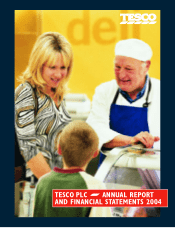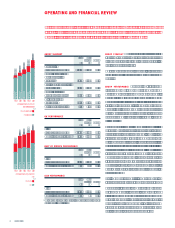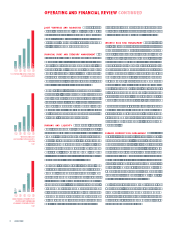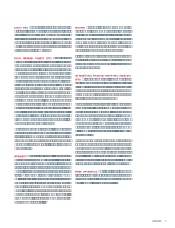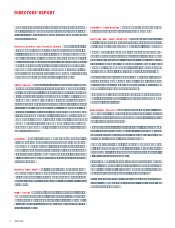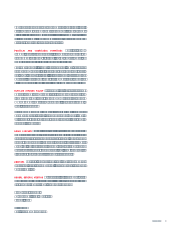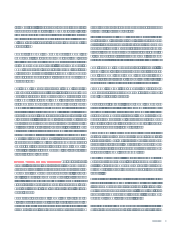Tesco 2004 Annual Report Download - page 11
Download and view the complete annual report
Please find page 11 of the 2004 Tesco annual report below. You can navigate through the pages in the report by either clicking on the pages listed below, or by using the keyword search tool below to find specific information within the annual report.TESCO PLC 9
instrumental in facilitating that process and providing continuity
throughout a period of transition. Mr G F Pimlott will retire
from the Board in May 2005. It is the Boards view that he
remains an independent member of the Board until then and
will submit himself for re-election as required by the Articles
of Association.
Remuneration Committee The Remuneration Committee,
composed entirely of independent Non-executive Directors,
is chaired by Mr C L Allen. The members are set out in the
table on page 12. The responsibilities of the Remuneration
Committee, together with an explanation of how it applies the
Directors remuneration principles of the Combined Code, are
set out in the Report of the Directors on Remuneration on
pages 13 to 23.
Audit Committee The Board has an Audit Committee, chaired
by Mr G F Pimlott and consisting entirely of independent Non-
executive Directors, which meets a minimum of three times a
year. Membership of the Audit Committee is set out in the
table on page 12. In July 2004, the chairmanship of the
Committee will pass to Mr K J Hydon who brings relevant and
recent financial experience. The Committees terms of reference
are reviewed annually and represent current best practice. Its
primary responsibilities include monitoring the system of internal
control throughout the Group, approving the Groups accounting
policies and reviewing the interim and annual financial statements
before submission to the Board. The Committee considers that
the company complies substantially with the Revised Combined
Code issued in 2003. The company is taking any necessary action
in order to be fully compliant with the new code before it
comes into effect next reporting year. The Audit Committee
has satisfied itself that the company complies with the principles
set out in the Smith Report.
INTERNAL CONTROL AND RISK MANAGEMENT The Board has overall
responsibility for internal control, including risk management, and
sets appropriate policies having regard to the objectives of the
Group. Executive management has the responsibility for the
identification, evaluation and management of financial and non-
financial risks and for the implementation and maintenance
of control systems across the Group in accordance with the
Boards policies and in line with best practice identified in the
Turnbull Report.
The Board, through the Audit Committee, has reviewed the
effectiveness of the systems of internal control for the accounting
year and the period to the date of approval of the financial
statements, although it should be understood that such systems
are designed to provide reasonable, but not absolute assurance,
against material misstatement or loss.
In addition to the Audit Committee, the company has in place
two further committees designed to monitor standards and manage
certain risks. These have been delegated to executive management
and are described below. For certain joint ventures, the Board
places reliance upon the systems of internal control operating
within our partners infrastructure and the obligations upon
partners Boards relating to the effectiveness of their own systems.
Compliance Committee The Board delegates its responsibilities
for compliance with all necessary laws and regulations to the
Compliance Committee. This Committee has established a
schedule for the regular review of the Groups operational activities
to ensure compliance with accepted practices and policies.
The Committee, comprising two Executive Directors, the
Company Secretary and three members of senior management,
normally meets four times a year.
Corporate Social Responsibility (CSR) Committee The Group
has an established cross-functional CSR Committee that meets
a minimum of four times a year. The CSR Committee is chaired
by the Group Company Secretary, and its membership is made
up of senior managers from all parts of the business. One of
its objectives is to identify threats and opportunities for the
coming year and to highlight emerging issues.
The CSR Committee uses CSR Key Performance Indicators
(KPIs) to track performance quarterly. The KPIs feed directly
into the Steering Wheel monitoring system explained below and
thus contribute to the overall monitoring of Group performance
and control evaluation by the Board. Regular reports are made
to the Executive Committee on CSR matters.
The risk management policies, procedures and monitoring
methods described below equally apply to the companys CSR
activities, including the management of social, ethical and
environmental risks, as advised by the ABI guidelines on social
responsibility.
The Board recognises that many investors and other stakeholders
take an interest in how companies are managing non-financial
risks. The company endeavours to provide detailed information
on its approach to corporate responsibility and its policies in
the annual Tesco Corporate Social Responsibility Review, and
on the website www.tesco.com/everylittlehelps
Internal Control Environment The Group has a five-year rolling
business plan. Every area and individual in the business is driven

